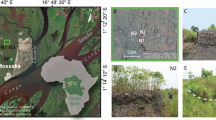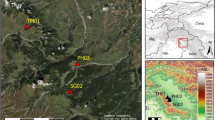Abstract
The adoption of cereal cultivation was one of the most important cultural processes in history, marking the transition from hunting and gathering by Mesolithic foragers to the food-producing economy of Neolithic farmers1. In the Lower Yangtze region of China, a centre of rice domestication2, the timing and system of initial rice cultivation remain unclear. Here we report detailed evidence from Kuahuqiao that reveals the precise cultural and environmental context of rice cultivation at this earliest known Neolithic site in eastern China, 7,700 calibrated years before present (cal. yr bp). Pollen, algal, fungal spore and micro-charcoal data from sediments demonstrate that these Neolithic communities selected lowland swamps for their rice cultivation and settlement, using fire to clear alder-dominated wetland scrub and prepare the site for occupation, then to maintain wet grassland vegetation of paddy type. Regular flooding by slightly brackish water was probably controlled by ‘bunding’ to maintain crop yields. The site’s exploitation ceased when it was overwhelmed by marine inundation 7,550 cal. yr bp. Our results establish that rice cultivation began in coastal wetlands of eastern China, an ecosystem vulnerable to coastal change but of high fertility and productivity, attractions maximized for about two centuries by sustained high levels of cultural management of the environment.
This is a preview of subscription content, access via your institution
Access options
Subscribe to this journal
Receive 51 print issues and online access
$199.00 per year
only $3.90 per issue
Buy this article
- Purchase on Springer Link
- Instant access to full article PDF
Prices may be subject to local taxes which are calculated during checkout


Similar content being viewed by others
References
Lu, T. L. D. The Transition from Foraging to Farming and the Origin of Agriculture in China (British Archaeological Reports International Series 774, John & Erica Hedges, Oxford, 1999)
Londo, J. P., Chiang, Y.-C., Hung, K.-H., Chiang, T.-Y. & Schaal, B. A. Phylogeography of Asian wild rice, Oryza rufipogon, reveals multiple independent domestications of cultivated rice, Oryza sativa. Proc. Natl Acad. Sci. USA 103, 9578–9583 (2006)
Zhao, Z. J. & Piperno, D. R. Late Pleistocene/Holocene environments in the middle Yangtze River valley, China and rice (Oryza sativa L.) domestication: the phytolith evidence. Geoarchaeology 15, 203–222 (2000)
Lu, H. et al. Rice domestication and climatic change: phytolith evidence from East China. Boreas 31, 378–385 (2002)
Higham, C. F. W. & Lu, T. The origins and dispersal of rice cultivation. Antiquity 72, 867–877 (1998)
Zhao, Z., Pearsall, D. M. & Jiang, Q. H. in Origins of Rice Agriculture (eds MacNeish, R. S. & Libby, J. G.) 47–52 (Univ. Texas Press, El Paso, 1995)
Wang, Y. et al. The Holocene Asian monsoon: links to solar changes and North Atlantic climate. Science 308, 854–857 (2005)
Zhao, Z. The middle Yangtze region in China is one place where rice was domesticated: phytolith evidence from the Diaotonghuan cave, northern Jiangxi. Antiquity 72, 885–897 (1998)
Crawford, G. W. & Shen, C. The origins of rice agriculture: recent progress in East Asia. Antiquity 72, 858–866 (1998)
Jiang, L. Kuahuqiao (Wenwu Press, Beijing, 2004)
Jiang, L. & Liu, L. The discovery of an 8000-year-old dugout canoe at Kuahuqiao in the Lower Yangtze River, China. Antiquity 79, Project Gallery 305 〈http://antiquity.ac.uk/projgall/liu/index.html〉 (2005)
Zheng, Y., Jiang, L.-P. & Zheng, J.-M. Study on the remains of ancient rice from Kuahuqiao site in Zhejiang province. Chin. J. Rice Sci. 18, 119–124 (2004)
Zong, Y. Mid-Holocene sea-level highstand along the southeast coast of China. Quat. Int. 117, 55–67 (2004)
Glover, I. C. & Higham, C. F. W. in The Origin and Spread of Agriculture and Pastoralism in Eurasia (ed. Harris, D. R.) 413–441 (UCL Press, London, 1996)
Tang, S., Sato, Y. I. & Yu, W. Discovery of wild rice grains (O. rufipogon) in the Hemudu ancient carbonized rice. Agric. Archaeol. 3, 88–122 (1994)
Jiang, Q. Searching for evidence of early rice agriculture at prehistoric sites in China through phytolith analysis: an example from central China. Rev. Palaeobot. Palynol. 89, 481–485 (1995)
Huang, F. & Zhang, M. Pollen and phytolith evidence for rice cultivation during the Neolithic at Longqiuzhuang, eastern Jianghuai, China. Veg. Hist. Archaeobot. 9, 161–168 (2000)
Bird, M. I. et al. An inflection in the rate of early mid-Holocene eustatic sea-level rise: a new sea-level curve from Singapore. Estuar. Coast. Shelf Sci. 71, 523–536 (2007)
Chen, Z., Wang, Z., Schneiderman, J., Tao, J. & Cai, Y. Holocene climate fluctuations in the Yangtze delta of eastern China and the Neolithic response. Holocene 15, 917–926 (2005)
Pike, A. W. Recovery of helminth eggs from archaeological excavations, and their possible usefulness in providing evidence for the purpose of an occupation. Nature 219, 303–304 (1968)
van Geel, B. & Aptroot, A. Fossil ascomycetes in Quaternary deposits. Nova Hedwigia 82, 313–320 (2006)
Mesleard, F. J., Lepart, J., Grillas, P. & Mauchamp, A. Effects of seasonal flooding and grazing on the vegetation of former rice fields in the Rhone delta (Southern France). Plant Ecol. 145, 101–114 (1999)
Graf, M.-T. & Chmura, G. L. Development of modern analogues for natural, mowed and grazed grasslands using pollen assemblages and coprophilous fungi. Rev. Palaeobot. Palynol. 141, 139–149 (2006)
Morton, J. F. Cattails (Typha spp.)—weed problem or potential crop? Econ. Bot. 29, 7–29 (1975)
Jiang, L. Hemudu—A Neolithic Site and its Archaeological Excavations (Wenwu Press, Beijing, 2003)
Zhao, S. & Wu, W.-T. Early Neolithic Hemudu culture along the Hangzhou estuary and the origin of domestic paddy rice in China. Asian Perspect. 27, 29–34 (1988)
Jiang, L. & Liu, L. New evidence for the origins of sedentism and rice domestication in the Lower Yangtze River, China. Antiquity 80, 355–361 (2006)
Fuller, D. Q., Harvey, E. & Qin, L. Presumed domestication? Evidence for wild rice cultivation and domestication in the fifth millennium BC of the Lower Yangtze region. Antiquity 81, 316–331 (2007)
Pei, A. Notes on new advancements and revelations in the agricultural archaeology of early rice domestication in the Dongting Lake region. Antiquity 72, 878–885 (1998)
Jarvis, D. Pollen evidence of changing Holocene monsoon climate in Sichuan province, China. Quat. Res. 39, 325–337 (1993)
Moore, P. D., Webb, J. & Collinson, M. Pollen Analysis (Blackwell, Oxford, 1991)
Clarke, C. M. In Aspects of Archaeological Palynology: Methodology and Applications (eds Davis, O. K. & Overs, J.) 53–62 (AASP Contributions Series 29, 1994)
Innes, J. B. & Simmons, I. G. Mid Holocene charcoal stratigraphy, fire history and palaeoecology at North Gill, North York Moors, UK. Palaeogeog. Palaeoclimatol. Palaeoecol. 164, 151–165 (2000)
Vos, P. C. & de Wolf, H. Diatoms as a tool for reconstructing sedimentary environments in coastal wetlands: methodological aspects. Hydrobiologia 269/270, 285–296 (1993)
Stuiver, M., Reimer, P. J. & Braziunas, T. F. High-resolution radiocarbon age calibration for terrestrial and marine samples. Radiocarbon 40, 215–230 (1998)
Acknowledgements
This research is funded by the Leverhulme Trust (to Y.Z.) and assisted by a visiting professorship by the East China Normal University, Shanghai, China (to Y.Z.).
Author Contributions Y.Z., Z.C. and C.C. worked on the project design. Z.C., C.C., Z.W. and H.W. helped with fieldwork and sample collection. Z.C. provided the radiocarbon dates. J.B.I. and Y.Z. analysed the microfossil data. Y.Z., Z.C. and J.B.I. wrote the paper. All authors discussed the results and commented on the manuscript.
Author information
Authors and Affiliations
Corresponding authors
Ethics declarations
Competing interests
Reprints and permissions information is available at www.nature.com/reprints. The authors declare no competing financial interests.
Rights and permissions
About this article
Cite this article
Zong, Y., Chen, Z., Innes, J. et al. Fire and flood management of coastal swamp enabled first rice paddy cultivation in east China. Nature 449, 459–462 (2007). https://doi.org/10.1038/nature06135
Received:
Accepted:
Issue Date:
DOI: https://doi.org/10.1038/nature06135
This article is cited by
-
Geographic mosaics of rice domestication in the lower Yangtze River indicated by morphological characteristics of rice bulliform phytoliths
Archaeological and Anthropological Sciences (2024)
-
Study on the origin of Asian cultivated rice based on 15 domestication regions
Genetic Resources and Crop Evolution (2023)
-
Response of rice to salinity risk- from a physiological outlook to laboratory focussed experimental approach
Cereal Research Communications (2023)
-
Plant hormone crosstalk mediated by humic acids
Chemical and Biological Technologies in Agriculture (2022)
-
Traditional agricultural management of Kam Sweet Rice (Oryza sativa L.) in southeast Guizhou Province, China
Journal of Ethnobiology and Ethnomedicine (2022)
Comments
By submitting a comment you agree to abide by our Terms and Community Guidelines. If you find something abusive or that does not comply with our terms or guidelines please flag it as inappropriate.



